
Kniphofia is a genus of perennial flowering plants in the family Asphodelaceae, first described as a genus in 1794. All species of Kniphofia are native to Africa. Common names include tritoma, red hot poker, torch lily and poker plant.

Ocimum is a genus of aromatic annual and perennial herbs and shrubs in the family Lamiaceae, native to the tropical and warm temperate regions of all 6 inhabited continents, with the greatest number of species in Africa. It is the genus of basil and its best known species are the cooking herb great basil, O. basilicum, and the medicinal herb tulsi, O. tenuiflorum.

Erythrococca is a plant genus of the family Euphorbiaceae, first described in 1849. It is native to Africa and the Arabian Peninsula.

Caperonia is a genus of plants of the family Euphorbiaceae first described as a genus in 1825. The genus is native to tropical and subtropical America and Africa.

Sumbaviopsis is a genus of plants in the family Euphorbiaceae first described as a genus in 1910. It contains only one known species, Sumbaviopsis albicans, native to Yunnan, the eastern Himalayas, and Southeast Asia.

Clutia is a plant genus of the family Peraceae. It is native to sub-Saharan Africa and to the Arabian Peninsula.

Adenochlaena is a genus of plant of the family Euphorbiaceae first described as a genus in 1858. It is native to certain islands in the Indian Ocean.
- Adenochlaena leucocephalaBaill. - Madagascar, Comoros
- Adenochlaena zeylanica(Baill.) Thwaites - Sri Lanka

Cephalocrotonopsis is a genus of plant of the family Euphorbiaceae first described as a genus in 1910. It contains only one known species, Cephalocrotonopsis socotranus, endemic to the Socotra Islands in the Indian Ocean, part of the Republic of Yemen.

Tragia is a genus of flowering plants in the spurge family, Euphorbiaceae. It is widespread across North and South America, Africa, the Arabian Peninsula, the Indian Subcontinent, northern Australia, and to various islands in the Caribbean and in the Indian Ocean.
Tragiella is a genus of plant of the family Euphorbiaceae first described as a genus in 1919. It is native to Africa.
- Tragiella anomala(Prain) Pax & K.Hoffm. - Tanzania, Malawi, Zambia
- Tragiella frieseana(Prain) Pax & K.Hoffm. - Zambia
- Tragiella natalensis(Sond.) Pax & K.Hoffm. - South Sudan, Kenya, Tanzania, Uganda, Malawi, Mozambique, Zimbabwe, Cape Province, KwaZulu-Natal, Limpopo, Mpumalanga
- Tragiella pyxostigmaRadcl.-Sm. - Tanzania
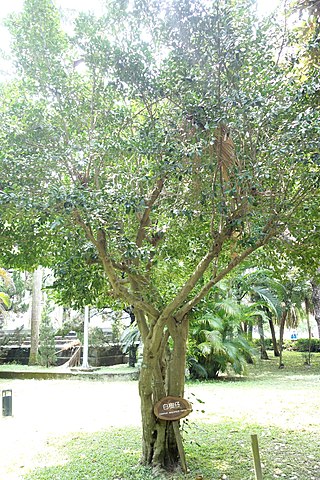
Suregada is a plant genus of the family Euphorbiaceae, first described as a genus in 1803. It is native to tropical and subtropical regions of Africa, the Indian Subcontinent, China, Southeast Asia, Australia, and certain oceanic islands.

Spirostachys is a plant genus of the family Euphorbiaceae first described as a genus in 1850. It is native to Africa. Zuloaga, F. O., O. Morrone, M. J. Belgrano, C. Marticorena & E. Marchesi. (eds.) 2008. Catálogo de las plantas vasculares del Cono Sur. Monographs in systematic botany from the Missouri Botanical Garden 107(1–3): i–xcvi, 1–3348.
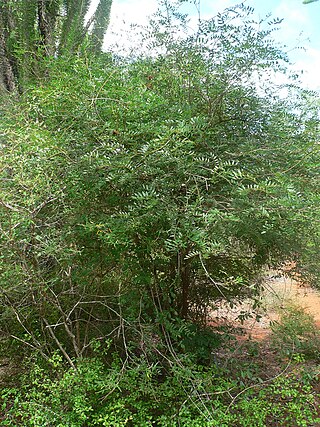
Cordyla is a genus of flowering plants in the family Fabaceae. It includes seven species native to sub-Saharan Africa, ranging across northern Africa from Senegal to Somalia, and through eastern Africa from Sudan to KwaZulu-Natal, including Madagascar.

Aneilema is a genus of monocotyledonous plants of approximately 60 species. The vast majority of the species are native to sub-Saharan Africa, but a few are found in Oceania and one, Aneilema brasiliense, is from South America. It is the third largest genus in the family Commelinaceae after Commelina and Tradescantia, and it is one of only six genera in the family to occur in both the Eastern Hemisphere and the Western Hemisphere.
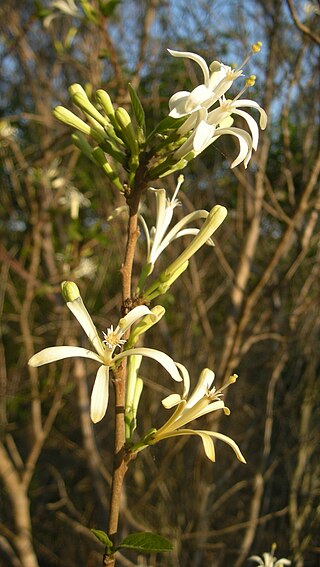
Turraea is a genus of plants in the family Meliaceae, native to the Old World tropics and subtropics.
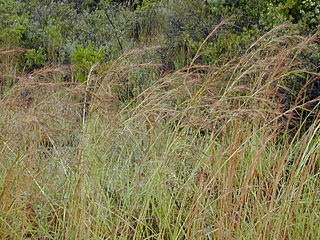
Hyparrhenia is a genus of grasses. Many species are known commonly as thatching grass.
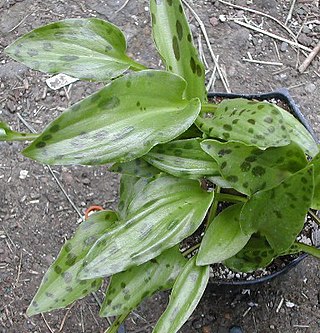
Drimiopsis is a genus of African bulbous perennial herbs in the family Asparagaceae, subfamily Scilloideae, native to sub-Saharan Africa. Sometimes species are placed under the genus Ledebouria.

Bridelia micrantha, the mitzeeri or the coastal golden-leaf, is a tree in the family Phyllanthaceae and is native to tropical and southern Africa as well as to the island of Réunion in the Indian Ocean.

Bonatea is a genus of orchids native to tropical and southern Africa, with one species extending into Yemen and Saudi Arabia.

Tetradenia (gingerbush) is a genus of plants in the family Lamiaceae, first described in 1830. It is native to Africa, including Madagascar.
- Tetradenia bainesii(N.E.Br.) Phillipson & C.F.Steyn - Zimbabwe, Mozambique, Eswatini, KwaZulu-Natal
- Tetradenia barberae(N.E.Br.) Codd - Cape Province
- Tetradenia brevispicata(N.E.Br.) Codd - Zimbabwe, Namibia, Botswana, Transvaal
- Tetradenia clementianaPhillipson - Madagascar
- Tetradenia cordataPhillipson - Madagascar
- Tetradenia discolorPhillipson - Zambia, Zaire, Zimbabwe, Malawi, Tanzania
- Tetradenia falafaPhillipson - Madagascar
- Tetradenia fruticosaBenth. - Madagascar
- Tetradenia galpinii(N.E.Br.) Phillipson & C.F.Steyn - southeast Africa from Tanzania to Eswatini
- Tetradenia goudotiiBriq. - Madagascar
- Tetradenia herbacea Phillipson - Madagascar
- Tetradenia hildeanaPhillipson - Madagascar
- Tetradenia isaloensisPhillipson - Madagascar
- Tetradenia kaokoensisvan Jaarsv. & A.E.van Wyk - Namibia
- Tetradenia multiflora(Benth.) Phillipson - Ethiopia
- Tetradenia nervosaCodd - Madagascar
- Tetradenia riparia(Hochst.) Codd - southern Africa from Angola + Malawi to Eswatini
- Tetradenia tanganyikaePhillipson - Malawi, Tanzania, Zambia
- Tetradenia tuberosaT.J.Edwards - KwaZulu-Natal
- Tetradenia urticifolia(Baker) Phillipson - eastern + central Africa from Sudan + Eritrea south to Zaire and Tanzania


















